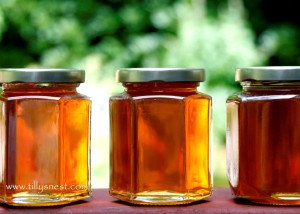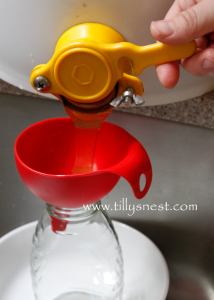
Here on Cape Cod, we have two opportunities to harvest honey, in the spring and fall. Some seasons we are lucky to have a fantastic nectar flow and this year the Black Locusts did not disappoint. They were abundant with blooms perfect for making sweet, delicious honey. I typically extract when I have at least two honey supers full of honey. Eighty percent of the comb should be fully capped on both sides of the frames set aside for harvesting. Extracting honey can be messy business and time consuming, so it is important that the quantity makes it worthwhile.
To extract the honey, you will need to remove the capped frames from the hive. There are several ways to remove the bees. Some people use escape boards and leaf blowers. I simply use a bee brush. About twenty feet away, I place an empty super on top of a piece of thick cardboard and lay a towel on top. One by one I remove a frame, brush off the bees, carry it over to the empty super, and place the frame inside. I cover the super back up with the towel to keep the bees out and repeat the process until the honey super is full. If there are more frames to harvest, I add another layer of cardboard on top of the full honey super and an empty super on top with the towel and continue on with the process. I am always very careful to not take away all the bees’ honey stores. I always try and leave at least a super full of honey for them to feed from. I don’t believe in taking all their honey and giving them sugar syrup instead. That’s just my point of view.

Next you will need to bring your honey to a place for harvesting that is away from the bees and a place where the bees cannot gain access. Some people use a shed, their kitchens or their garage. I prefer the garage. I prep the garage floor with a lining of plastic sheeting. Then I cover that up with newspaper. Next, I add the extractor to the center of my protected workspace. I place a small table near the extractor. On the table, I place a large cookie sheet and the uncapping tool. I also keep a small bucket of warm water and a towel nearby. They are perfect for rinsing off my sticky hands when necessary.
Once ready, I retrieve the honey supers and bring them into the garage and close up the doors. One by one I remove the frames from the super. Over the cookie sheet, I run the uncapping tool over all the capped combs. I start from the top and work my way to the bottom. I flip the frame over and repeat the process on the back. I then add the uncapped frame to the extractor. I repeat this process until all the slots in the extractor are full. From here on out, I find an extra set of hands helpful and frequently enlist a beekeeper friend.
We use a hand crank extractor. We crank the frames in one direction for about five minutes. Then we repeat the spinning direction for another five minutes. We check the frames to see if they are light as a feather. The frames will still be wet with honey but they should be almost weightless. We return the wet frames to the honey super. After the entire extraction process, the honey supers will be placed back onto the hives for the bees to clean off the wet frames. Within a couple of days, the frames are empty and dry. We leave one super on for the bees to begin storing honey in again (unless it is fall) and return the other one to the shed until it is needed for use again.

Once all the frames have been extracted, we place a food-grade five-gallon plastic bucket underneath the spout on the extractor. We line the bucket with a mesh bag to filter out bits of wax and the like. Next, we open the gate and allow the honey to flow into the bucket. We scrape the sides of the extractor to be sure to get as much honey out of the extractor. Once satisfied, we tie off the mesh bag with a piece of rope and hang it so the honey flows from the bag into the bucket. This can sometimes be an overnight process. Once the bag has only bee debris remaining, the honey is ready for pouring into jars. Those bits left in the mesh bag- empty them onto a plate and set them in the garden away from the hives. The bees will clean that of honey too! You’ll be left with wax dust that can be melted down for beeswax and used in candles and beauty products.

Next, we take the five-gallon bucket in the kitchen and place it over the kitchen sink. I have a spout on the bucket too which allows us to easily fill the jars. For narrow mouth jars, we use a funnel, for the wide mouth jars, we do not use the funnel. Be sure to fill each jar up to the neck and seal it with a cap. Repeat until you have filled your jars with honey.
To clean the extractor, we move outside with a drop of dish soap and lots of water. We rinse it clean. The mesh bag and five-gallon bucket can be cleaned in the same way. We set them aside to dry in the sun.
I am always amazed to see how different the color and taste is of the honey over the seasons. Based on the blooms the bees visit my honey always tastes different. Spring honey is always light in color and in taste. Fall’s honey is always darker, amber-like and has rich bold taste. How was your honey harvest this year?
Author’s Note: I live in the Northeast on the coast of Massachusetts on Cape Cod. As I mention harvesting times, this applies to my area. Depending on where you live, you may be harvesting honey at different times of the year.
About the author: Melissa Caughey is a backyard chicken keeper, beekeeper, and gardener who writes the award-winning blog Tilly’s Nest. Melissa lives on Cape Cod, Massachusetts, with her family. She regularly writes for HGTV Gardens, Community Chickens, and Grit magazine, and she contributes to Country Living magazine. Her blog was named one of Better Homes and Gardens magazine’s Top 10 Gardening Blogs and received Country Living magazine’s Blue Ribbon Blogger Award.










6 Comments
Message*if I order one of your set up how long will it take before I received it
Great video. Want to get into bee keeping .Learning as much as possible before I start my hives.Keep up the good work.
Thanks Melissa for sharing this article with us. I have a question. Which is the best idea for safe extracting of honey? Currently, I am using homemade honey extractors.
More pictures or short vids. please.
I have a question.. I’ve extracted and placed the wet frames back on the hive.. After the bees are done, do I just store the frames “as is” or should I scrape away all the wax comb that’s remaining.. I’m a beginner and don’t intend to use the wax.
Thanks for sharing this useful information ,regards.
Ayurvedic Products online store